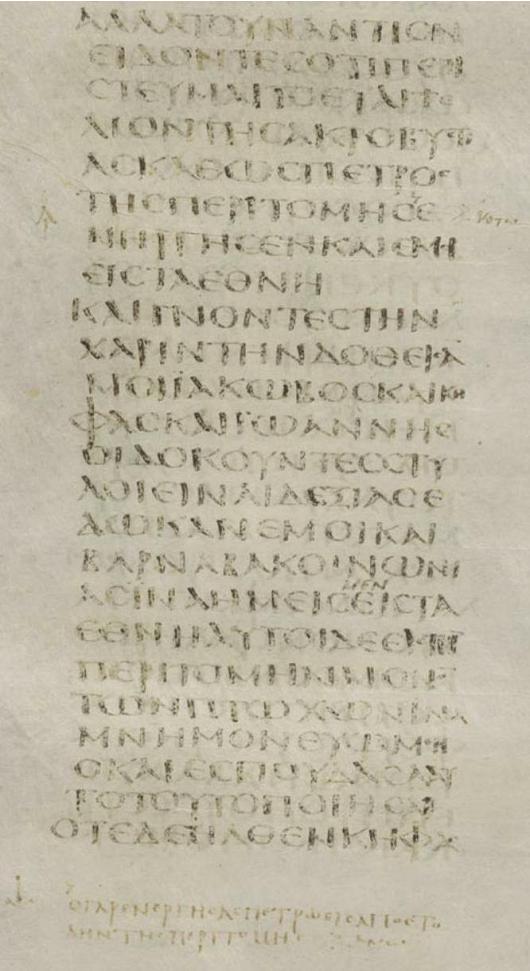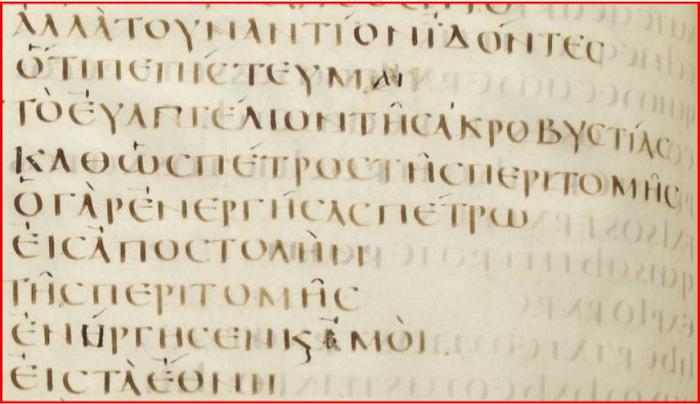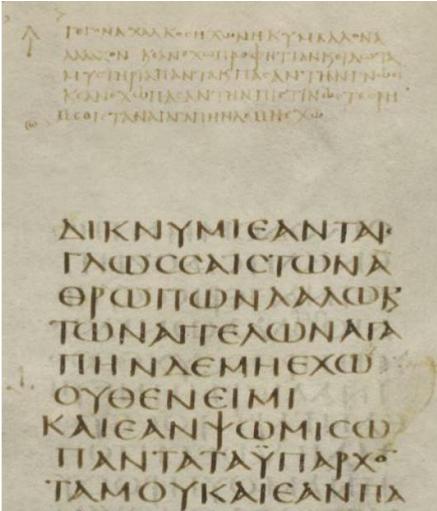






Homeoteleuton (homoeoteleuton) is in general terms, the use of word endings that are similar or the same during the copying of text. For our purpose, an error in copying the text is made because of the similar word endings.
Below, we show a number of examples of homeoteleuton found in Codex Sinaiticus, that we believe clearly identifies the exemplar text for part of the manuscript.
1. 1 Corinthians 13:1-2
Several lines of text were omitted from 1 Corinthians 13:1-2 in the main text of Codex Sinaiticus and were added later as a correction in the margin. The scribe appears to have mistaken a line of text in his exemplar for an identical line of text several lines up and skipped the lines of text between the two identical lines.
One manuscript has been identified as the likely exemplar - Codex Claromontanus. In this manuscript, the identical text that brackets the text omitted in Sinaiticus, is contained in two identical lines of text, making it very easy to make this copying mistake, and extremely likely that Codex Claromontanus is indeed the source text.
Below, we show a number of examples of homeoteleuton found in Codex Sinaiticus, that we believe clearly identifies the exemplar text for part of the manuscript.
1. 1 Corinthians 13:1-2
Several lines of text were omitted from 1 Corinthians 13:1-2 in the main text of Codex Sinaiticus and were added later as a correction in the margin. The scribe appears to have mistaken a line of text in his exemplar for an identical line of text several lines up and skipped the lines of text between the two identical lines.
One manuscript has been identified as the likely exemplar - Codex Claromontanus. In this manuscript, the identical text that brackets the text omitted in Sinaiticus, is contained in two identical lines of text, making it very easy to make this copying mistake, and extremely likely that Codex Claromontanus is indeed the source text.







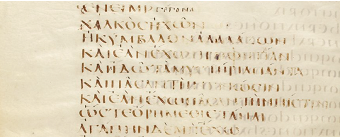










Note in the images above that the line at the end of Section 1 and the line at the end of Section 2 are identical. This identical line of text made it easy for the scribe of Codex Sinaiticus to accidentally skip over the whole of Section 2, and carry on copying at the beginning of Section 3.
This identification of Codex Claromontanus as a likely source text for 1 Corinthians 13 in Codex Sinaiticus poses a problem for those who date Codex Sinaiticus to the 4th Century AD. Codex Claromontanus is dated to the 6th Century AD.
If Codex Claromontanus was indeed used as a source text for Codex Sinaiticus, then Sinaiticus must be dated to the 6th Century or later - possibly much later.
More information on this homeoteleuton is included in the following documents:
1. Presentation of a Textbook Case of Homeoteleuton
2. A Layman's Guide to the Textbook Case
3. Description of the Discovery of the 1 Corinthians 13 Homeoteleuton
This identification of Codex Claromontanus as a likely source text for 1 Corinthians 13 in Codex Sinaiticus poses a problem for those who date Codex Sinaiticus to the 4th Century AD. Codex Claromontanus is dated to the 6th Century AD.
If Codex Claromontanus was indeed used as a source text for Codex Sinaiticus, then Sinaiticus must be dated to the 6th Century or later - possibly much later.
More information on this homeoteleuton is included in the following documents:
1. Presentation of a Textbook Case of Homeoteleuton
2. A Layman's Guide to the Textbook Case
3. Description of the Discovery of the 1 Corinthians 13 Homeoteleuton
"In not a few places we find a few words left out, whose omission reduces the passage to mere nonsense, but which would just fill up a line in an old papyrus, the error being palpably due to the shifting of the copyist's eye from one line to the next: accidents like these making it clear that the scribe had before him for his model no printed book, but a roll answering to the manuscript line for line."
- F. H. A. Scrivener, Six Lectures on the Text of the New Testament and the Ancient Manuscripts Which Contain It ,second lecture
- F. H. A. Scrivener, Six Lectures on the Text of the New Testament and the Ancient Manuscripts Which Contain It ,second lecture
2. A second homeoteleuton that strengthens the evidence that Codex Claromontanus was used as an exemplar for Codex Sinaiticus is found in 1 Corinthians 2:14-15.
Like in our first example, there are three sections in the exemplar. The Section 1 and Section 2 both have identical endings (highlighted in the image of Codex Claromontanus), creating a situation where Section 2 is accidentally ommitted from the copy because the scribe mistakes the final letters of Section 2 for the final letters of Section 1.
The copy contains Section 1 and Section 3 in the main text. In this case, Section 2 is found as a correction in the margin of Codex Sinaiticus as shown in the images below.
Like in our first example, there are three sections in the exemplar. The Section 1 and Section 2 both have identical endings (highlighted in the image of Codex Claromontanus), creating a situation where Section 2 is accidentally ommitted from the copy because the scribe mistakes the final letters of Section 2 for the final letters of Section 1.
The copy contains Section 1 and Section 3 in the main text. In this case, Section 2 is found as a correction in the margin of Codex Sinaiticus as shown in the images below.















More in depth infomation on this homeoteleuton is found in this paper by W. R. Meyer.



3. A third example from 2 Corinthians 4:17 is presented in this document by W. R. Meyer. The images below clearly show how the copyist's eye skipped from a set of letters to the same set of letters in the next line. The scribe knew what the last letter was, and what the next letter was going to be and when his eye came back to the exemplar, it picked up the second instance of that combination, not the first and correct instance. Hence, the scribe accidentally omitted the last half of the fourth line and the first half of the fifth line. This section is found in corrections on both sides of the column of text in Codex Sinaiticus.








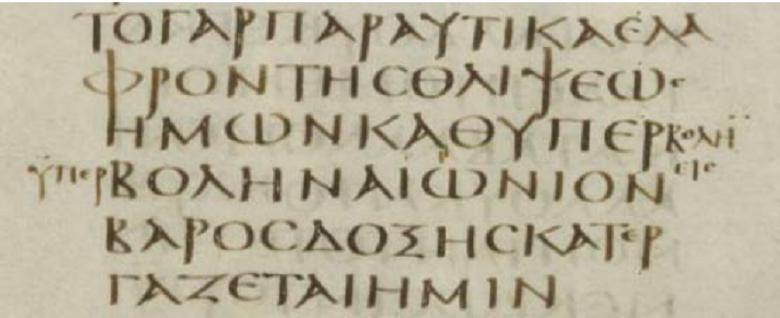










Further homeoteleuton evidence is currently being compiled that shows likely source documents for Codex Sinaiticus. Check back soon, as more examples will be added to this page!
4. A fourth example from Galatians 2:8 is presented in this document by W. R. Meyer.
